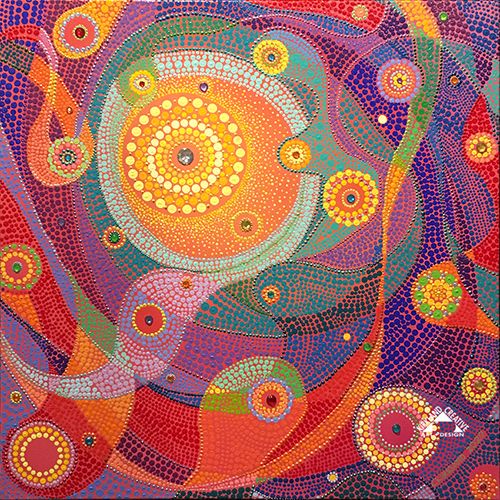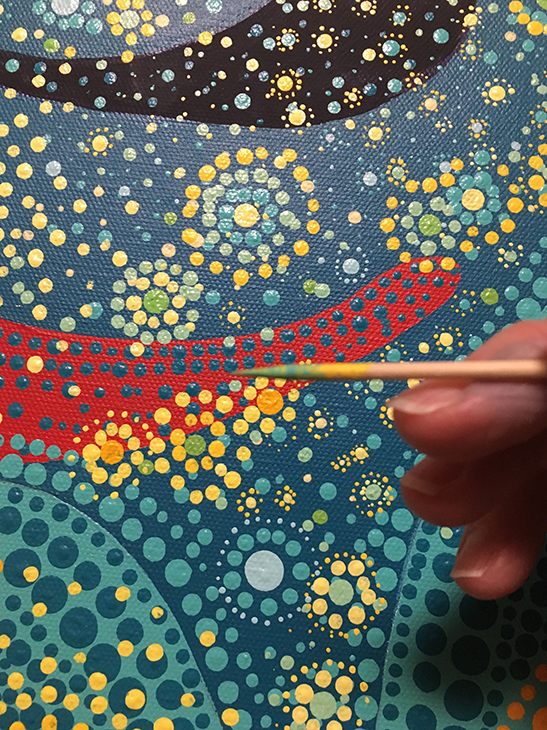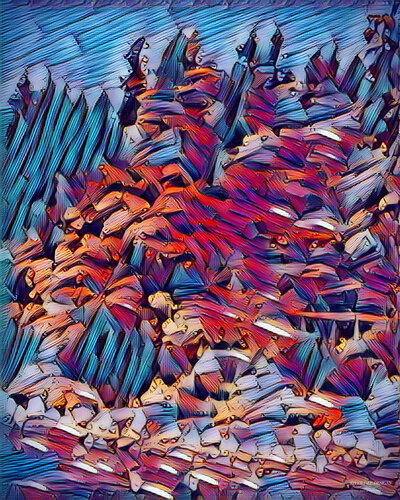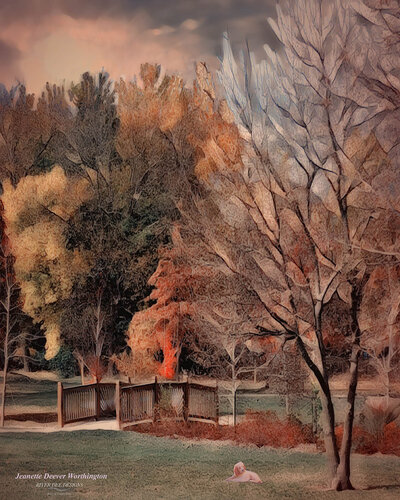by guest bloggers Catherine Kirkland and Catharine Deever
Both traditionally made and digitally created artwork offer benefits to artists and collectors.

“Organic Complexity” mixed media on canvas, 24″ x 24″ by Catherine Kirkland
When one is shopping for artwork to enhance a living or working space, there are many choices. One of them is traditional art—original works created by hand with conventional materials such as paint and brush. Another option that is gaining in popularity is digitally created artwork, made exclusively with software on a computer or other device. How does the collector determine whether one is a better value or a better creation than the other?
The first consideration is whether the artwork connects with the collector on a visual or emotional level. Regardless of how it was produced, that’s the most important facet. After deciding that the work is appealing, the collector may be curious to know more about the creation process.
Traditional method
Should the collector be considering a space-themed, pointillist painting by artist Catherine Kirkland, they will be viewing a work created with acrylic paint on canvas which took months to complete.
Kirkland’s complex, large-scale paintings begin by prepping a canvas with gesso. She then draws the design, based on a sketch or space photograph, onto the canvas with pencil. Added layers of color using brushes form the under-painting. After the under-painting is complete, Kirkland individually applies painted dots with dowels or other tools to create detail, movement, and depth. The finished painting is a one-of-a-kind original that is vibrant and richly textured, featuring metallic highlights that are not achievable digitally.

Kirkland uses a bamboo skewer to create dots in a pointillist painting.
Kirkland works with conventional tools such as brushes and painting knives as well as unconventional ones like dowels, skewers, forks and spoons. She also employs a professional imaging service to create high-resolution digital images of her finished paintings. As the artist, she retains the rights to all reproductions from these image files. She may then license those images to others. Or she might use them to create products such as archival prints and custom-printed consumer products, as well as animations for display on corporate screens.
Digital method
By comparison, a collector might consider the purchase of a digitally created artwork. They may harbor the misconception that it was created solely by software, without the eye and creativity of an artist at the controls. This of course is not the case. Digital art creation is a complex, artist-driven, hands-on process. It requires proficiency with software and a working knowledge of devices such as a tablet and stylus in lieu of paint and canvas.
Digital artist Catharine Deever credits the use of advancing technology and emerging digital tools to better serve her clients. This offers speed, ease and the convenience of technology. She is able to sync her clients’ vision and their needs with the creation of the final artwork.

“Waves Against the Cliff” digital painting by Catharine Deever
Creating a one-of-a-kind or part of a limited-edition digital artwork requires different tools. Deever’s digital images are based on photographs that she or a talented family photographer have taken. She loads them into both Adobe Photoshop and Corel Painter. Then she manipulates lines in Photoshop and experiments with color using Corel Painter.
Using both software tools, she adjusts opacity and color saturation, then refines shades, integrates/blends layers, and focuses light. Scores of versions are created before the final work is completed.
She crops the image, saturates the color, and alters digital dimensions. These determinations are based on the purpose for the digital art. It may be published as a mass-market product or integrated into a consumer product such as clothing, bedding, tech products, luggage, etc. Or it may be sold as a single piece of wall art, signed by the artist.
Digital tools make it convenient for clients to see drafts quickly. It allows them to provide feedback more specifically, regardless of their geographic location. The space in which the artwork will be placed is readily negotiated, with fewer costs and increased ease.

“Autumn Bridge” digital painting by Catharine Deever
What’s the difference to the client?
Regardless of how an image is created, elements and principles of art apply to both digital and the conventional works. Color, composition, scale, rhythm, texture, and contrast are important in creating a quality work of art. A skilled artist, whether digital or traditional, will understand these aesthetic elements and incorporate them.
Kirkland believes traditional artists offer clients the opportunity to own a textured, tangible, one-only piece of art, created by the hand of an artist. The collector knows there are no other identical pieces and can take pride in the ownership of unique work.
Deever is thankful for the digital tools that provide her clients a broader selection of visual wonder and delight in both their personal and work spaces. Her tools allow her, the news media, institutions, and communities to not only see and work outside the box—it liberates them from the box altogether.
Both Kirkland and Deever believe that artists should use the tools that work best for them, and that clients should fill their environments with those visuals that best inspire them.
Is digital art better than traditionally created art? The subjective answer to that question is in the eye of the beholder and the collector.
About the Authors:
During her creative career as an art director, graphic designer, and production manager, Catherine Kirkland embraced and bridged the transition from conventionally produced graphic designs and print materials, into computer graphics, production and distribution. She is known regionally as a pointillist painter who creates space-inspired works in acrylic on canvas.
Following a successful career in administration, education and advocacy, digital artist Catharine Deever has been pursuing her passion. She creates landscape and abstract compositions through modifying and manipulating digital photography.


I’ve always felt that the manipulation of pixels is wear creativity begins. Results fail and succeed to other people. The journey or process continues growth. My favorite question I get “thats a composite isn’t it? So what, Do you like it? As if they need to know how to respond…. Not all people realize that every photo is a manipulation.